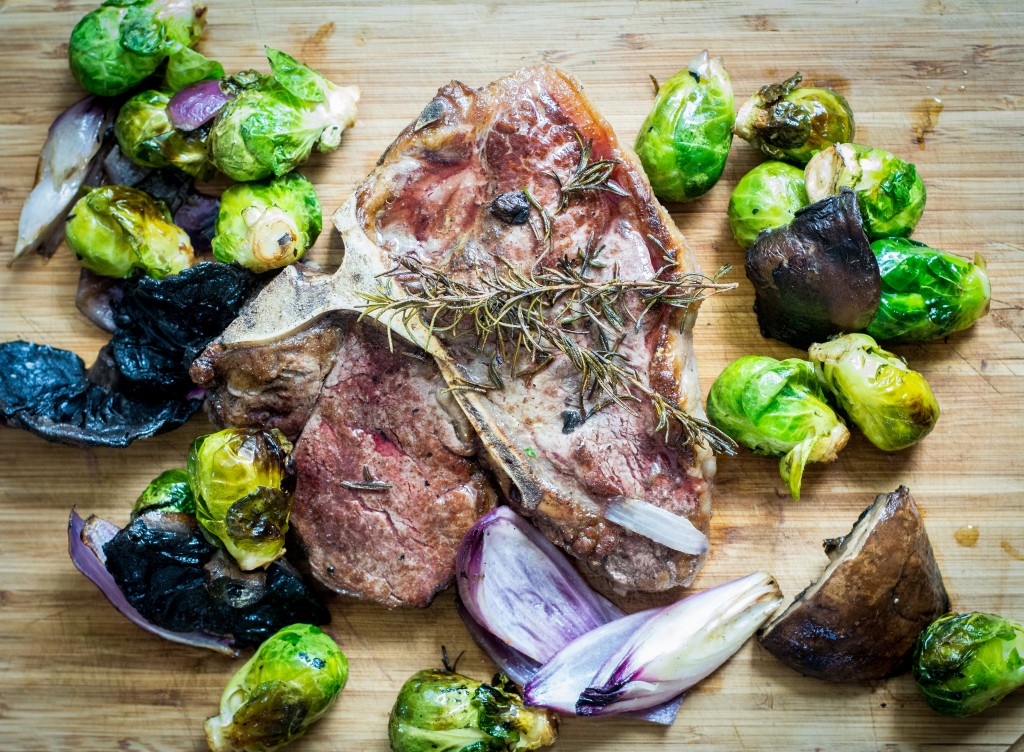Caveman T-Bone Steak
Cooking steaks can sometimes be a very difficult task, if you don’t know what you are doing. But if you cook it just right, steaks are probably one of the most delicious meals you can ever cook.
With the Paleo craze, I know many of my readers will want to hear about this Caveman T-Bone Recipe.
Plus, this is a sheet-pan dinner so it’s easy to make, and easy to clean up.
T-bone steaks are one of the most popular steaks and they are called this because they have a bone shaped like the letter T. On one side you have the tenderloin, and on the other, the strip loin. Delicious.
First, let me remind you of a few tips to cook a steak:
USDA Prime or Choice?
First, if you can afford it, choose USDA Prime over Choice. The quality makes a difference. Angus beef is a fantastic breed, and so is Hereford.
Corn or grass-fed?
Next, you must decide if you’re going to go towards corn-fed or grass-fed. That’s a question of taste. Corn-fed beef is very tender and tasty. Mainly because the marbling is more apparent. Marbling is important, and it’s one of the qualities you must consider when choosing a steak.
Grass-fed is more of an acquired taste, much leaner, and for that reason, more difficult to cook right.
Making a great golden-brown crust
This is the most satisfying part of eating a steak: the crust. To build a great crust, you need to make sure that:
- The steaks are dry and free of water. Pat dry with paper towels if needed.
- You brush the steaks with a bit of extra-virgin olive oil.
- You use a cast-iron skillet, or a performing grill.
- You monitor the heat to avoid burning or a weak sear.
I usually sear in a cast-iron skillet or a grill to build that lovely crust, then if necessary, I finish cooking the steaks in the oven (350 degrees F) or on the top rack of the grill, covered, at lowered heat.
In this recipe, you will spend a bit of time making that crust.
Choosing a thicker cut of steak is important. In fact, for this recipe, it’s essential (otherwise a 30-minute cooking time will give you a well-done steak). First, thicker cuts provide a much better mouthfeel and texture. So it’s important for that reason alone. Furthermore, a thick cut offers a much better control of the heat. When you think about it, heat travels slower through a thick cut, and therefore the window between undercooking and overcooking is much wider, and more permissive of errors.
I recommend using a thermometer to monitor the heat. That’s the surest way to get your steak at the right temperature for your tastes.
Other old wives’ tales, such as pressing parts of your hand to tell if the steak is done, are no good.
| Steak doneness | Remove from heat source at this temperature | Final cooked temperature |
| Rare | 125 degrees F | 130 degrees F |
| Medium rare | 135 degrees F | 140 degrees F |
| Medium | 145 degrees F | 150 degrees F |
| Well done | I’m not talking to you | Go away |
To season, I recommend rosemary, and simple salt and pepper. But any rub you choose is fine. The goal, again, is to make sure you have a nice golden-brown crust. That’s where it’s at.
Also, just like the sheet pan dinners (link to sheet pans dinners), you can substitute the vegetables, as long as they can cook in less than 30 minutes. I’m choosing Brussels sprouts and Portobello mushrooms here but others would work: Green beans, zucchini, yellow squash, eggplant, red peppers, etc… Just cut them thick.
Prep time: 20 minutes | Cook time: 30 minutes | Yield: 4-6 servings |
Note: A 2 inch thick steak will be medium and finish cooking at the same time as the vegetables. For a different doneness, follow these guidelines:
Rare: 125° | Medium Rare: 135° | Medium: 145 °
Ingredients:
1 (1 ½ pound) T-Bone steak, 1 1/2 to 2 inches thick
2 lbs Brussels sprouts
2 red onions, peeled and quartered
7 large Portobello mushrooms, halved
1 tbsp extra-virgin olive oil
3 sprigs of rosemary
Salt and pepper to taste
Preparation:
1. Preheat oven to 450 degrees F (convection if you have it)
2. Pat the steak dry with paper towels.
3. Heat a large roasting pan on the burner at medium high until hot.
4. Drizzle oil over the steak and use your fingers or a brush to spread it evenly over the steak and on the sides. Sprinkle with salt and pepper. Flip the steak and repeat on the other side.
5. Sear the steak and the rosemary for 30 seconds. It should sizzle immediately. Flip and sear the other side for 30 seconds.
6. Add Brussels sprouts, mushrooms, onions, and toss in the pan with the remaining olive oil. Add salt and pepper to taste.
7. Roast in the oven for 30 minutes.
8. Take the steak and vegetables out of the oven and transfer them to a large cutting board.
9. Tent them loosely with aluminum foil and let the steak rest for about 15 minutes.
10. Slice the steak and fan slices out on each plate. Serve immediately. Enjoy!
More Steak Recipes:

